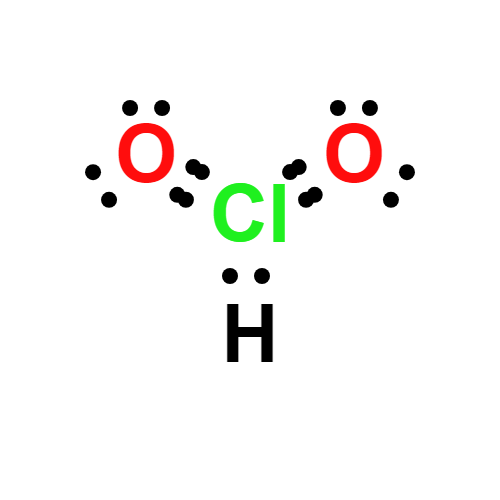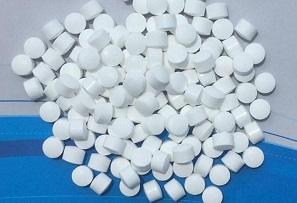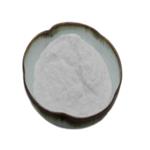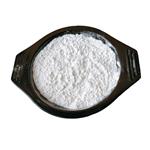Chlorine dioxide
- CAS No.
- 10049-04-4
- Chemical Name:
- Chlorine dioxide
- Synonyms
- ClO2;Chlorine oxide;Chlorine Dioxide solution;Alcide;o2Cl(.);(Oclo)(.);doxcide50;JUN-CLARE;Doxcide 50;alcide[qr]
- CBNumber:
- CB5268845
- Molecular Formula:
- ClO2
Lewis structure

- Molecular Weight:
- 67.45
- MDL Number:
- MFCD01732063
- MOL File:
- 10049-04-4.mol
| Melting point | -59°C |
|---|---|
| Boiling point | 11°C |
| Density | 3.09g/L |
| vapor pressure | 0-22900Pa at 20-25℃ |
| solubility | slightly soluble in H2O |
| form | orange-green gas |
| color | orange-green |
| Water Solubility | Soluble ºC |
| Exposure limits | TLV-TWA 0.1 ppm (0.3 mg/m3); (ACGIH, MSHA, OSHA, and NIOSH); TLV-STEL 0.3 ppm (ACGIH); IDLH 10 ppm (NIOSH). |
| Dielectric constant | 1.7(77.0℃) |
| Stability | May decompose explosively on shock, friction or concussion, or on heating rapidly. Strong oxidant - reacts violently with combustible and reducing materials, and with mercury, ammonia, sulphur and many organic compounds. |
| EPA Primary Drinking Water Standard | MCL:MRDL=0.81,MCLG:MRDLG=0.81 |
| LogP | -3.22--2.9 at 20℃ |
| FDA 21 CFR | 173.300; 137.105; 165.110 |
| Substances Added to Food (formerly EAFUS) | CHLORINE DIOXIDE |
| CAS DataBase Reference | 10049-04-4(CAS DataBase Reference) |
| EWG's Food Scores | 3 |
| FDA UNII | 8061YMS4RM |
| NIST Chemistry Reference | Chlorine dioxide(10049-04-4) |
| EPA Substance Registry System | Chlorine dioxide (10049-04-4) |
| Pesticides Freedom of Information Act (FOIA) | Chlorine dioxide |
SAFETY
Risk and Safety Statements
| Symbol(GHS) |    GHS06,GHS05,GHS09 |
|---|---|
| Signal word | Danger |
| Hazard statements | H301-H314-H400 |
| Precautionary statements | P264-P270-P301+P310-P321-P330-P405-P501-P260-P264-P280-P301+P330+P331-P303+P361+P353-P363-P304+P340-P310-P321-P305+P351+P338-P405-P501-P273-P391-P501 |
| Hazard Codes | O,T+,N |
| Risk Statements | 6-8-26-34-50 |
| Safety Statements | 23-26-28-36/37/39-38-45-61 |
| RIDADR | UN 9191 |
| IDLA | 5 ppm |
Chlorine dioxide Chemical Properties,Uses,Production
Description
Chlorine dioxide is a yellow to reddish-yellow gas that can decompose rapidly in air. Because it is a hazardous gas, chlorine dioxide is always made at the location where it is used. Chlorine dioxide is used as a bleach at pulp mills, which make paper and paper products, and in public water-treatment facilities, to make water safe for drinking. It has also been used to decontaminate public buildings. Chlorine dioxide is soluble in water and will react rapidly with other compounds. When it reacts in water, chlorine dioxide forms chlorite ion, which is also a very reactive chemical. Because chlorine dioxide is very reactive, it is able to kill bacteria and microorganisms in water. About 5% of large water-treatment facilities (serving more than 100,000 persons) in the United States use chlorine dioxide to treat drinking water. An estimated 12 million persons may be exposed in this way to chlorine dioxide and chlorite ions. In communities that use chlorine dioxide to treat drinking water, chlorine dioxide and its byproduct, chlorite ions, may be present at low levels in tap water.

chlorine dioxide tablets
Uses
Wood-pulp bleaching is the largest use of chlorine dioxide, which is a uniquely selective oxidizer for lignin. In general, the trend in the pulp industry has been to eliminate chlorine and hypochochlorite as bleaching agents and replace them with chlorine dioxide. Since chlorine dioxide functions via an oxidative reaction rather than a chlorinating reaction, the formation of chlorinated organic compounds is limited. Also, unlike other oxidizing agents, chlorine dioxide does not attack cellulose, and thus preserves the mechanical properties of bleached pulp. In the final stages of the pulp-bleaching processes, chlorine dioxide is the most frequently used bleaching chemical. A unique whiteness can be achieved using chlorine dioxide in kraft pulp, sulfite pulp, and soda pulp processes. In the United States, the firststage of the pulp-bleaching process makes use of mixtures of chlorine and chlorine dioxide to reduce the formation of organic chlorine compounds (EPA 2002c; Kaczur and Cawlfield 1993; Vogt et al. 1986).
In the textile industry, chlorine dioxide is used as a bleaching agent and produces high-quality textile fibers with additional qualities. For example, “shrinkproof” wool owes its qualities to the reaction of chlorine dioxide with the cross-linking sulfur atoms of the wool.
health effects
Both chlorine dioxide and chlorite react quickly in water and moist body tissues. If you were to breathe air containing chlorine dioxide gas, you might experience irritation in your nose, throat, and lungs. If you were to eat or drink large amounts of chlorine dioxide or chlorite, you might experience irritation in the mouth, esophagus, or stomach. Most people will not be exposed to chlorine dioxide or chlorite in amounts large enough to damage other parts of the body, but if you were, you might experience shortness of breath and other respiratory problems because of damage to the substances in blood that carry oxygen throughout the body.
Animal studies have shown effects of chlorine dioxide and chlorite that are similar to those seen in people exposed to very high amounts of these chemicals. In addition, exposure to high levels of chlorine dioxide and chlorite in animals both before birth and during early development after birth may cause delays in brain development. The levels to which the animals were exposed were much higher than levels that would likely be found in drinking water that has been disinfected with chlorine dioxide.
environmental effects
Chlorine dioxide is a very reactive compound. In air, sunlight quickly breaks chlorine dioxide apart into chlorine gas and oxygen. In water, chlorine dioxide reacts quickly to form chlorite ions. When chlorine dioxide reacts with dissolved organic compounds in water-treatment systems, it forms disinfection by-products, such as chlorite and chlorate ions. Like chlorine dioxide, chlorite is very reactive. Since chlorite is an ionic compound, it will exist primarily in water. Chlorite ions are mobile in water, and may move into groundwater. However, the reaction of chlorite ions with soils and sediments may reduce the concentration of chlorite ions capable of reaching groundwater.
Production
Chlorine dioxide is always manufactured on site because of the risk of rapid decomposition. In all processes, chlorine dioxide is produced in strong acid solutions from either sodium chlorite or sodium chlorate. Small- and medium-scale industrial production of chlorine dioxide utilizes sodium chlorite as the raw material. This is typical of water treatment and disinfection applications that require high purity (i.e., chlorine-free) waters. Other applications not requiring high purity waters utilize sodium chlorate. This is typical of pulp bleaching where large quantities of chlorine dioxide are necessary. There are several processes used to generate chlorine dioxide from sodium chlorate. In the R2 process, chlorine dioxide is produced from sodium chlorate and sulfuric acid, with sodium chloride as the reducing agent. Chlorine dioxide is absorbed from the gas phase in packed towers in cold water, and chlorine leaves the system as a by-product. In the Mathieson process, a sulfur dioxide-air mixture is diffused into a solution of sodium chlorate and sulfuric acid. Sulfur dioxide is used as the reductant to produce chlorine dioxide with a much lower chlorine content. The process also produces sulfuric acid, reducing the overall acid requirement. Exit gases from the Mathieson process are passed through a scrubber to remove any unreacted sulfur dioxide. The Solvay process uses sodium chlorate and sulfuric acid, with methanol as the reducing agent. Products from this process are chlorine dioxide, formic acid, and carbon dioxide. In improved Solvay processes, sulfuric acid demand is reduced by crystallizing out the by-products sodium sulfate, sodium sesquisulfate, or sodium bisulfate (Kaczur and Cawlfield 1993; Vogt et al. 1986).
Description
Chlorine dioxide is a flammable, reddish-yellow gas or reddish-brown liquid (below 11℃/52°F) with anirritating odor like chlorine or nitric acid. Molecularweight=67.46; Specific gravity (H2O:1)=1.6 (liquid at0℃); Boiling point=11℃; Freezing/Meltingpoint=259℃; Relative vapor density (air=1)=2.3;Vapor pressure=.1 atm at 20℃. Explosive Limits in air:.10%. Hazard Identification (based on NFPA 704 MRating System): Health 3, Flammability 3, Reactivity 3(Shock; Oxidizer). Soluble in water (reactive);solubility=0.3% at 25℃.
Chemical Properties
Chlorine dioxide,CI02, is a yellow-reddish gas.It is a very effective bleaching and water treatment agent. Chlorine dioxide is preparedby the reaction of chlorine and sodium chlorite. It is quite unstable and is commonly prepared immediately before use.
Chemical Properties
Chlorine dioxide is a flammable, reddishyellow gas, or reddish-brown liquid (below 11C/52F) with an irritating odor like chlorine or nitric acid.
Physical properties
Yellow to red-yellow gas at room temperature; pungent chlorine-like odor; density 9.99 g/L at 11°C; liquefies to a reddish brown liquid at 11°C; liquid density 1.64 g/mL at 0°C; freezes at -59.5° C to red crystals (explodes); soluble in water, decomposes in hot water; soluble in alkalis and H2SO4.
Uses
Chlorine dioxide is used for several purposes,including its applications as a bleachingagent to bleach fats, oils, textiles, cellulose,paper pulp, flour, and leather. It is also usedfor purifying water; as an oxidizing agent;as an antiseptic; and in the manufacture ofmany chlorite salts.
Uses
Chlorine Dioxide is a gas used in bleaching and aging flour. it acts on the flour almost instantly, resulting in improved color and dough properties. because usage levels are low, the bleaching action is limited.
Uses
Bleaching cellulose, paper-pulp, flour, leather, fats and oils, textiles, beeswax; purification of water; taste and odor control of water; cleaning and detanning leather; manufacture of chlorite salts; oxidizing agent; bactericide, antiseptic and deodorizer.
Definition
chlorine dioxide: A yellowish-redexplosive gas, ClO2; d. 3.09 g dm–3;m.p. –59.5°C; b.p. 9.9°C. It is solublein cold water but decomposed by hotwater to give chloric(VII) acid, chlorine,and oxygen. Because of its highreactivity, chlorine dioxide is bestprepared by the reaction of sodiumchlorate and moist oxalic acid at90°–100°C, as the product is then dilutedby liberated carbon dioxide.Commercially the gas is produced bythe reaction of sulphuric acid containingchloride ions with sulphurdioxide. Chlorine dioxide is widelyused as a bleach in flour milling andin wood pulping and also finds applicationin water purification.
Definition
An orange gas formed by the action of concentrated sulfuric acid on potassium chlorate. It is a powerful oxidizing agent and its explosive properties in the presence of a reducing agent were used to make one of the first matches. It is widely used in the purification of water and as a bleach in the flour and wood-pulp industry. On an industrial scale an aqueous solution of chlorine dioxide is made by passing nitrogen dioxide up a tower packed with a fused mixture of aluminum oxide and clay, down which a solution of sodium chlorate flows.
Preparation
Chlorine dioxide is prepared by passing nitrogen dioxide through sodium chlorate packed in a column:
NaClO3 + NO2 → NaNO3 + ClO2
Also, it may be prepared by the reaction of chlorine with sodium chlorite:
2NaClO2 + Cl2 → 2ClO2 + 2NaCl
Alternatively, it may be obtained by the treatment of sodium chlorate or potassium chlorate with sulfur dioxide and sulfuric acid:
2NaClO3 + SO2 + H2SO4 → 2ClO2 + 2 NaHSO4.
Production Methods
Chlorine dioxide is manufactured from the oxidation of chlorite or the reduction of chlorate. The latter method is used for large-volume production and is carried out in strongly acidic solution using reducing agents such as NaCl, HCl, sulfur dioxide, and methanol.
Hazard
Explodes when heated or by reaction with organic materials. Very irritating to skin and mucous membranes. Lower respiratory tract irritant. Broncitis.
Health Hazard
Chlorine dioxide is highly irritating to theeyes, nose, and throat. Inhalation can causecoughing, wheezing, respiratory distress, andcongestion in the lungs. Its toxicity inhumans is moderate to high. Its irritanteffects in humans can be intense at a con centration level of 5 ppm in air. A concen tration of 19 ppm of the gas inside a bleachtank caused the death of one worker (Elkins 1959). The chronic toxicity signs are mainlydyspnea and asthmatic bronchitis, and in cer tain cases irritation of the gastrointestinaltract. Ingestion of the liquid may cause som nolence and respiratory stimulation.
Fire Hazard
Nonflammable gas; however, it is highly reactive and a strong oxidizing agent. Chlo rine dioxide explodes violently upon heating, exposure to sunlight, contact with dust, or when subjected to a spark. Detonation occurs at concentrations above 10% in air in the presence of an energy source or catalyst. It undergoes violent reactions with organic matter; explosion occurs when the mixture is subjected to shock or a spark. It reacts spon taneously with sulfur or phosphorus, caus ing ignition and/or explosion. Liquid chlorine dioxide may explode violently when mixed with mercury, caustic potash, caustic soda, or many metal hydrides. The gas reacts explo sively with fluorine and with difluoroamine (Lawless and Smith 1968).
Flammability and Explosibility
Not classified
Safety Profile
Moderately toxic by inhalation. Experimental reproductive effects. Mutation data reported. An eye irritant. A powerful explosive sensitive to spark, impact, sunlight, or heating rapidly to 100℃. A powerful oxidzer. Concentrations of greater than 10% in air are explosive. Explodes on mixing with carbon monoxide, hydrocarbons (e.g., butadiene, ethane, ethylene, methane, propane), fluoramines (e.g., difluoramine, trifluoramine). Mtxtures with hydrogen explode with sparking or contact with platinum. Explodes on contact with mercury, potassium hydroxide, phosphorus pentachloride + chlorine. Ignites or explodes on contact with nonmetals (e.g., phosphorus, sulfur, sugar). Reacts violently with F2, NHF2. Reacts with water or steam to produce toxic and corrosive fumes of HCl. When heated to decomposition it emits toxic fumes of Cl-. See also CHLORINE.
Potential Exposure
Chlorine dioxide is used in bleaching cellulose pulp; bleaching flour; water purification; as a liquid sterilizer in an ultrasonic cleaner.
First aid
If this chemical gets into the eyes, remove anycontact lenses at once and irrigate immediately for at least15 min, occasionally lifting upper and lower lids. Seek medical attention immediately. If this chemical contacts theskin, remove contaminated clothing and wash immediatelywith soap and water. Seek medical attention immediately. Ifthis chemical has been inhaled, remove from exposure,begin rescue breathing (using universal precautions, including resuscitation mask) if breathing has stopped and CPR ifheart action has stopped. Transfer promptly to a medicalfacility. When this chemical has been swallowed, get medical attention. Give large quantities of water and inducevomiting. Do not make an unconscious person vomit.Medical observation is recommended for 24-48 h afterbreathing overexposure, as pulmonary edema may bedelayed. As first aid for pulmonary edema, a doctor orauthorized paramedic may consider administering a corticosteroid spray.
storage
Color Code—Red Stripe: Flammability Hazard:Store separately from all other flammable materials. Prior toworking with chlorine dioxide you should be trained on itsproper handling and storage. This chemical is a powerful oxidizer, and is shock-, light- and heat-sensitive. It is violentlyexplosive in air at concentrations over 10%. Keep frozenwhen not in use. Store in tightly closed containers in a cool,dark, well-ventilated area at temperatures well below 130℃.Gas explosions may occur above 130℃. Use only nonsparking tools and equipment, especially when opening and closingcontainers of this chemical. Sources of ignition, such assmoking and open flames, are prohibited where this chemicalis used, handled, or stored in a manner that could create apotential fire or explosion hazard. Use explosion-proof electrical equipment and fittings in storage area. See OSHAStandard 1910.104 and NFPA 43A Code for the Storage ofLiquid and Solid Oxidizers for detailed handling and storageregulations.
Shipping
UN/NA 9191 Chlorine dioxide, hydrate, frozen, Hazard class: 5.1; Labels: 5.1-Oxidizer, 6.1-Poison Inhalation. Explosive: It may only be shipped in the frozen state and then only by private or contract motor carrier.
Incompatibilities
Unstable in light. A powerful oxidizer. Chlorine dioxide gas is explosive at concentrations over 10% and can be ignited by almost any form of energy, including sunlight, heat (explosions can occur in air in temperature above 130C), or sparks, shock, friction, or concussion. This chemical reacts violently with dust, combustible materials; and reducing agents. Reacts violently with mercury, phosphorus, sulfur, and many compounds, causing fire and explosion hazard. Contact with water forms perchloric and hydrochloric acid. Corrosive to metals.
Waste Disposal
Use large volume of concentrated solution of ferrous salt or bisulfite solution as reducing agent. Then neutralize and flush to sewer with abundant water.
Chlorine dioxide Preparation Products And Raw materials
Raw materials
1of3
Preparation Products
| Supplier | Tel | Country | ProdList | Advantage | |
|---|---|---|---|---|---|
| Hebei Yanxi Chemical Co., Ltd. | +8617531190177 | peter@yan-xi.com | China | 5993 | 58 |
| Hebei Guanlang Biotechnology Co,.LTD | +8619930503252 | daisy@crovellbio.com | China | 5964 | 58 |
| Henan Bao Enluo International TradeCo.,LTD | +86-17331933971 +86-17331933971 | deasea125996@gmail.com | China | 2503 | 58 |
| Shanghai Daken Advanced Materials Co.,Ltd | +86-371-66670886 | info@dakenam.com | China | 15928 | 58 |
| Henan Tianfu Chemical Co.,Ltd. | +86-0371-55170693 +86-19937530512 | info@tianfuchem.com | China | 21691 | 55 |
| Hefei TNJ Chemical Industry Co.,Ltd. | +86-0551-65418679 +86-18949832763 | info@tnjchem.com | China | 2989 | 55 |
| Shanxi Naipu Import and Export Co.,Ltd | +86-13734021967 +8613734021967 | kaia@neputrading.com | China | 1011 | 58 |
| Hebei Guanlang Biotechnology Co., Ltd. | +86-19930503282 | alice@crovellbio.com | China | 8823 | 58 |
| Xiamen AmoyChem Co., Ltd | +86-592-6051114 +8618959220845 | sales@amoychem.com | China | 6387 | 58 |
| Hubei xin bonus chemical co. LTD | 86-13657291602 | linda@hubeijusheng.com | CHINA | 22968 | 58 |
Related articles
- What is chlorine dioxide used for?
- Chlorine dioxide is the most widely used bleaching agent, in particular for high-quality cellulose. It destroys lignin without....
- Mar 16,2024
- Overview of ClO2 Polarity
- Chlorine dioxide with the exists as yellowish-green gas above 11 °C, a reddish-brown liquid between 11 °C and -59 °C, and as b....
- Dec 28,2023
- Preparation Method of Chlorine dioxide
- Chlorine dioxide is a yellowish-green, irritating, neutral chlorine compound with the formula ClO2. It is liquefied into reddi....
- Oct 11,2019
View Lastest Price from Chlorine dioxide manufacturers
| Image | Update time | Product | Price | Min. Order | Purity | Supply Ability | Manufacturer | |
|---|---|---|---|---|---|---|---|---|
 |
2024-04-24 | Chlorine dioxide
10049-04-4
|
US $2780.00-2770.00 / Tons | 10Tons | 99.99% | 100Tons | Hebei Dangtong Import and export Co LTD | |
 |
2023-09-18 | Chlorine dioxide
10049-04-4
|
US $50.00 / kg | 1kg | 0.99 | 10000 | Hebei Yanxi Chemical Co., Ltd. | |
 |
2023-08-25 | Chlorine Dioxide
10049-04-4
|
US $10.00 / KG | 1KG | 10% | 50 ton | Hebei Guanlang Biotechnology Co,.LTD |
-

- Chlorine dioxide
10049-04-4
- US $2780.00-2770.00 / Tons
- 99.99%
- Hebei Dangtong Import and export Co LTD
-

- Chlorine dioxide
10049-04-4
- US $50.00 / kg
- 0.99
- Hebei Yanxi Chemical Co., Ltd.
-

- Chlorine Dioxide
10049-04-4
- US $10.00 / KG
- 10%
- Hebei Guanlang Biotechnology Co,.LTD
10049-04-4(Chlorine dioxide )Related Search:
1of4





